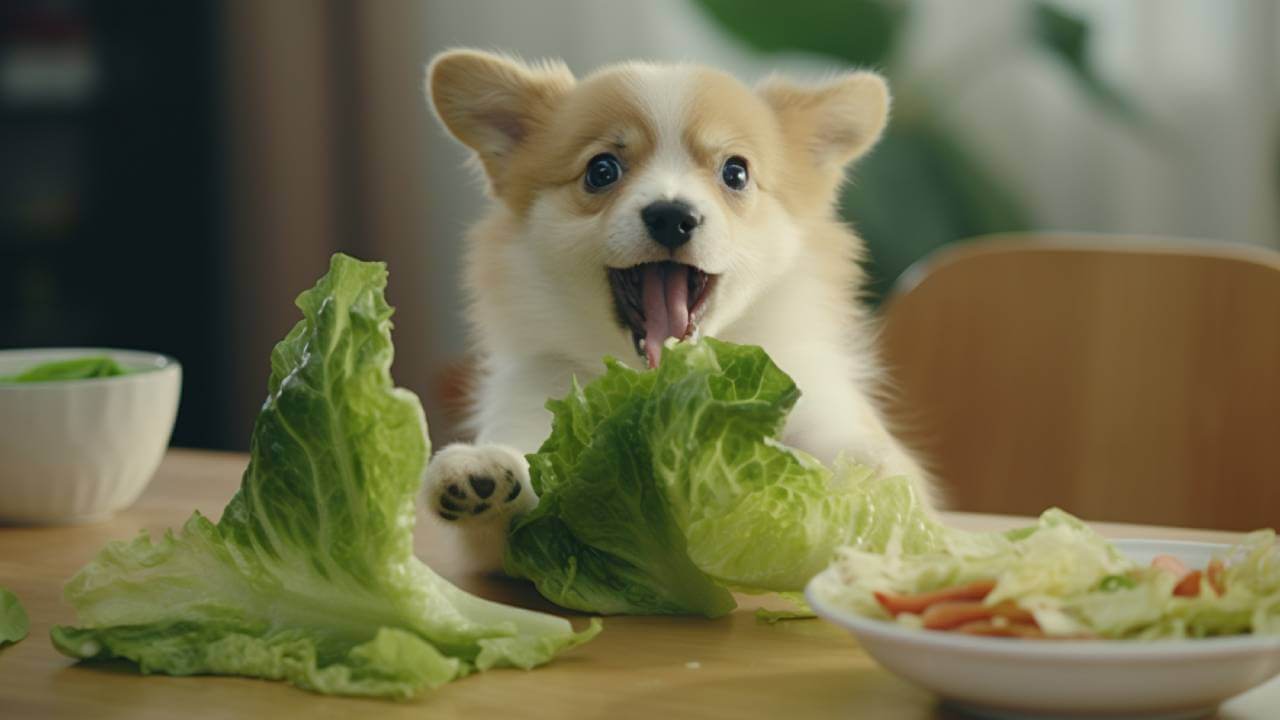Dogs can safely enjoy many of the same vegetables humans do, and lettuce is no exception. This leafy green is safe for canine consumption and offers a range of health benefits, providing hydration and essential nutrients with minimal calories.
Whether you want to add a crunchy texture to your dog’s meals or simply want a healthy treat option, feeding your dog lettuce can be smart. Let`s learn together about the benefits and considerations of feeding lettuce to dogs so you can make informed decisions about your furry friend’s diet!
Is Lettuce Good for Dogs?
Lettuce can be a healthy addition to your dog’s diet when served in small amounts. It’s rich in vitamins A and K, which support your pup’s eye health and overall well-being. Additionally, lettuce provides dietary fiber, which can aid in digestion.
Furthermore, lettuce in your dog’s diet can benefit overweight or obese dogs. This leafy green is incredibly low in calories, making it an excellent choice for dogs needing to shed a few pounds or maintain a healthy weight.
Lettuce is primarily composed of water, which can help keep your pup well-hydrated. In addition to its nutritional value, lettuce can serve as a hydrating snack for your dog, especially during the hot summer months.
Is Lettuce Safe for Dogs?
Let’s find out if it is safe for your furry friend:
- Generally safe for dogs.
- It should be given in moderate amounts
- Avoid lettuce with high-calorie dressings or toppings.
- Always wash lettuce thoroughly to remove pesticides and dirt.
- Introduce lettuce gradually to monitor your dog’s digestive system’s tolerance to it.
- Steer clear of seasonings and opt for plain raw lettuce.
- Be careful with Iceberg lettuce as it is less nutritious and harder to digest.
Can Lettuce Be Bad for Dogs?
While lettuce is generally safe for dogs in moderation, there are some potential risks and considerations to keep in mind:
- Gastrointestinal Upset: Some dogs may experience digestive upset when introduced to new foods, including lettuce. It can lead to diarrhea, gas, or an upset stomach. Start with small amounts to prevent this, and monitor your dog’s reaction.
- Choking: Large pieces of lettuce or whole leaves can pose a choking hazard, especially for small dogs. Always cut lettuce into small, manageable pieces to reduce the risk.
- High-Calorie Additions: When offering lettuce to your dog, be cautious about adding high-calorie dressings, toppings, or condiments. These can add unnecessary calories and potentially harmful ingredients like onions or garlic.
Like humans, some dogs may have allergies or sensitivities to certain foods, including lettuce. If you notice any signs of allergies, such as itching, redness, or gastrointestinal issues, discontinue offering lettuce. Consider exploring dog insurance plans to protect your pet in case of unexpected health issues.
How Much Lettuce Can Your Dog Eat?
While lettuce is safe, it should only be used as an occasional treat in moderation. A few small pieces of lettuce are sufficient for smaller breeds. This equates to about one or two leaves, chopped, depending on the size and type of lettuce. For medium to larger breeds, you can add a small handful of chopped lettuce to their regular meals as a treat or mix it in for extra crunch and nutrition.
As a general guideline, lettuce should make up no more than 10% of your dog’s daily diet.

How to Feed Lettuce to Dogs
Giving lettuce to your dog can be a healthy treatment option when done correctly. Here’s a step-by-step guide to do it safely and enjoyable for your dog:
- Prepare bite-sized pieces. Chop the lettuce into small, bite-sized pieces your dog can easily chew and swallow. This minimizes the risk of choking and aids in digestion.
- Wash it thoroughly (very important). Always wash the lettuce thoroughly under running water to remove pesticides, dirt, or other contaminants.
- Mix lettuce with regular food. Mix lettuce into your dog’s regular food to make it more appealing and well-tolerated. This can help them get used to the texture and taste of lettuce mixed with familiar flavors.
Never add salad, condiments, or toppings to the lettuce. Many ingredients, like onions and garlic, are toxic to dogs. You can explore more about why onions are poisonous for dogs.
Remember that while lettuce can be a healthy addition to your dog’s diet, it should be offered as an occasional treat or supplement to their primary diet.
Dogs can enjoy lettuce as an occasional addition to their diet; it offers some health benefits and can be a refreshing treat. However, always practice moderation and ensure the lettuce is clean and free from harmful substances. If you have any doubts or concerns about your dog’s diet, it’s best to consult with your veterinarian.

FAQs
Can all dog breeds eat lettuce?
Not all dogs have the same digestive tolerance. While most dogs can enjoy lettuce in moderation, some may have sensitive stomachs. Always introduce new foods gradually and monitor your dog’s reaction.
Can I give my dog lettuce from my salad with dressing?
It’s best to avoid dressings as they often contain ingredients that are unhealthy for dogs, such as garlic and onions. Stick to plain, washed lettuce for your furry friend.
Are there any types of lettuce to avoid?
Iceberg lettuce is the least nutritious variety and can be challenging for dogs to digest. Opt for darker, leafy greens like romaine or spinach for better nutritional value.
Can lettuce replace other dog treats?
Lettuce can be a healthy alternative to high-calorie dog treats, but it should not replace the balanced diet your dog needs. Puppies can eat lettuce moderately, but their digestive systems are still developing. Offer small amounts and ensure it doesn’t upset their stomach.
Resources:
- The Roles of Plant-Based Ingredients and Phytonutrients in Canine Nutrition and Health: This section helps us understand the nutritional benefits of plant-based dog ingredients.
- Growing Fruits and Vegetables for Your Dog: Learn how to grow fruits and vegetables safely for your canine friend.
- What Vegetables Can Dogs Eat: Find out which vegetables are beneficial and safe for your dog.






I’ve heard lettuce is safe for dogs, but are there any benefits
I often give my dog lettuce as a snack, but I’m curious if it provides any real health benefits for him…